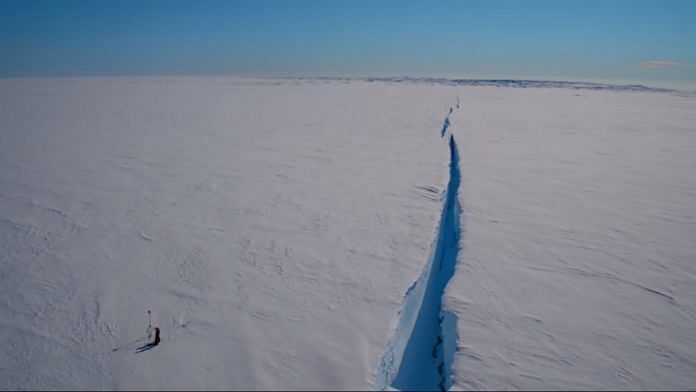Bengaluru: The icy continent of Antarctica recorded its highest-ever temperature Thursday, the 6th of February 2020, as mercury soared to 18.3 degrees Celsius at midday. For comparison, Delhi’s noon temperature Saturday was 21 degrees Celsius and Shimla’s 6 degrees Celsius.
The temperature reading was initially revealed by a tweet from Argentina’s meteorological agency, which has been recording temperatures there since 1961.
#Antártida | Nuevo récord de temperaturas 🌡️
Este mediodía la Base #Esperanza registró un nuevo récord histórico (desde 1961) de temperatura, con 18,3°C. Con este valor se supera el récord anterior de 17,5°C del 24 en marzo de 2015. Y no fue el único récord… pic.twitter.com/rhKsPFytCb
— SMN Argentina (@SMN_Argentina) February 6, 2020
The last heat record for the Antarctic mainland came in 2015, when temperatures reached 17.5 degrees Celsius on 24 March.
Although it is summer in the South Pole currently, the hottest month is usually January. Average highs at the coastal Esperanza Base are well below 5 degrees C.
Speaking to journalists in Geneva, World Meteorological Organisation (WMO) spokesperson Clare Nullis said “18.3°C… is not a figure you would normally associate with Antarctica even in summertime”. The WMO, a United Nations agency, said it would set up an expert panel to analyse the temperature reading, which was recorded at the Argentine Esperanza Base on the northern tip of the continent.
The highest temperature in the Antarctic region was recorded in January 1982 — 19.8 degrees Celsius at Signy Island just off the mainland.
Also read: There was a warning about climate change in 1988. It was right
Warming at alarming rate
The part of Antarctica on which Esperanza Base is situated is warming the fastest each year. Over the last 50 years, temperatures here have increased by nearly 3 degrees Celsius through accelerated retreat of ice.
The fact that a new heat record has been set within five years of the last one is worrying.
Another Argentinian base, called Marambio, which is 100 km from Esperanza, also recorded a high for February at 14.1 degrees Celsius on Thursday. The previous high was witnessed on 24 February 2013, 13.8 degrees Celsius. This region is quite warm, and has seen a high of 15 degrees Celsius in summer.
The ongoing climate crisis, with new warming records set pretty much every year, has placed the Earth on the precipice of catastrophe. The January that’s gone by, for example, was the warmest ever for the world, if marginally.
More such record-breaking highs are expected to come in rapid succession in the future.
Research bases
The coastal bases of Esperanza and Marambio are two of 13 Argentinian research bases on Antarctica. They remain occupied throughout the year. Marambio is the bigger and more important of the two, and is home to Antarctica’s first air strip.
Marambio Base has 27 buildings spread out over 20,000 square metres. It is capable of permanently housing 45 residents, a capacity that can stretch to 200 when needed. Esperanza Base is much smaller and houses around 55 residents. It is also where Argentinian Emilio Palma became the first person to be born in Antarctica.
The base is situated on the closest part of the continent to South America, and is claimed by Argentina as part of its national territory. The claim isn’t recognised internationally.
Warm winds and retreating glaciers
The weather phenomenon that plays a major role in Antarctic warming is called the Foehn wind (pronounced “fern”) — dry, warm and strong winds that flow down a mountain or higher elevation.
Antarctica’s landmass is mountainous and irregular, and lends itself to strong winds that blow over slopes. As winds blow downwards, air pressure builds up near the ground and causes more warming.
Foehn winds typically lead to rapid temperature rise and disappearance of snow cover.
Ice loss also happens below the surface, as the gigantic floating chunks of ice come in contact with warmer oceanic waters. Satellite monitoring in recent days has revealed large cracks in glaciers in Antarctica, said Nullis, which can be seen growing rapidly and drastically.
Nullis added that almost “87 per cent of glaciers along the west coast of the Antarctic Peninsula have retreated in the last 50 years, with most of these showing an accelerated retreat in the last 12 years”.
Antarctica is twice the size of Australia, and its ice sheet is almost 5 km thick. The ice in Antarctica is believed to hold over 85 per cent of the world’s freshwater.
Consequences of ice melt
Antarctica is warming five times faster than the rest of the world, and this effect can also be seen in the Southern Ocean, which surrounds Antarctica. On average now, 250 billion tonnes of ice melts per year as compared to 40 billion from the 1970s until 1990.
As temperatures rise and ice melts, the large influx of freshwater into the ocean surrounding Antarctica changes sea currents and affects marine ecosystems. This, in turn, affects marine ecosystems around the world, and the sea currents alter world weather on a global scale.
Melting of ice is also raising sea levels. If all of the ice melts on the continent, sea levels would rise by a staggering 60 metres. If emissions continue at current scale, sea levels are expected to rise by 2 to 8 inches before the year 2100, threatening coastal cities like Mumbai, Chennai and New York.
As multiple climate tipping points are reached, scientists continue calling for urgent action to curtail emissions and contain the rise of global temperatures within 1.5 degrees Celsius over those seen during the industrial revolution.
Also read: Preventing climate change is a human rights issue



